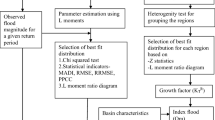Abstract.
A comparison of different methods for estimating T-year events is presented, all based on the Extreme Value Type I distribution. Series of annual maximum flood from ten gauging stations at the New Zealand South Island have been used. Different methods of predicting the 100-year event and the connected uncertainty have been applied: At-site estimation and regional index-flood estimation with and without accounting for intersite correlation using either the method of moments or the method of probability weighted moments for parameter estimation. Furthermore, estimation at ungauged sites were considered applying either a log-linear relationship between at-site mean annual flood and catchment characteristics or a direct log-linear relationship between 100-year events and catchment characteristics. Comparison of the results shows that the existence of at-site measurements significantly diminishes the prediction uncertainty and that the presence of intersite correlation tends to increase the uncertainty. A simulation study revealed that in regional index-flood estimation the method of probability weighted moments is preferable to method of moment estimation with regard to bias and RMSE.
Similar content being viewed by others
Author information
Authors and Affiliations
Rights and permissions
About this article
Cite this article
Kjeldsen, T., Rosbjerg, D. Comparison of regional index flood estimation procedures based on the extreme value type I distribution. Stochastic Environmental Research and Risk Assessment 16, 358–373 (2002). https://doi.org/10.1007/s00477-002-0104-6
Issue Date:
DOI: https://doi.org/10.1007/s00477-002-0104-6




